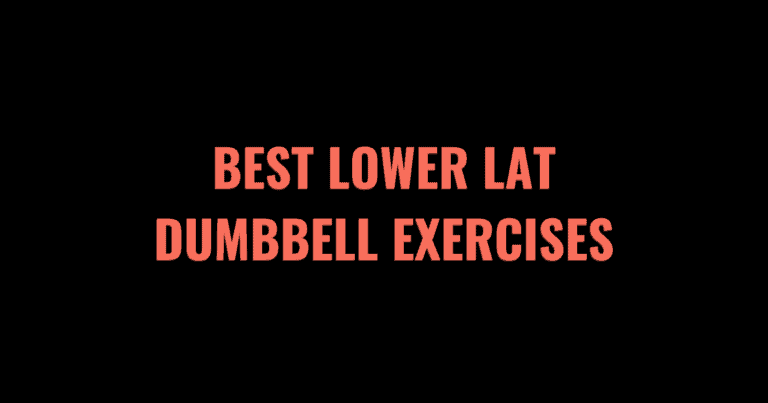When most people think about the best shoulder exercises, they often prioritize movements that work the front (anterior) and side (medial) deltoids. However, focused attention on the posterior (rear) delt is equally important for building strong, well-rounded shoulders.
Strengthening the rear delts will improve your ability to pull your shoulders back, and improve your strength and posture in and out of the gym. You can target your rear delts using cable machines, barbells, resistance bands, or even your own body weight.
In this article, we’ll focus on ways to target the posterior deltoid using only dumbbells for an accessible, convenient way to train this often neglected muscle.
Here is our list of the nine best dumbbell exercises to target your rear delt and help you build broad, strong, and stable shoulders.
Table of Contents
- 1 The 9 Best Rear Deltoid Dumbbell Exercises
- 1.1 1. Bent Over Standing Rear Dumbbell Flys
- 1.2 2. Side-Lying Rear Delt Dumbbell Raises
- 1.3 3. Incline Dumbbell Rear Delt Flys
- 1.4 4. Dumbbell Face Pulls
- 1.5 5. Bent Elbow Standing Dumbbell Lateral Raises
- 1.6 6. Dumbbell Incline Y Raises
- 1.7 7. Dumbbell Single-Arm Bent Over Rows
- 1.8 8. Supported Single-Arm Bent Over Reverse Dumbbell Flys
- 1.9 9. Seated Bent-Over Rear Delt Rows
- 2 Rear Delt Workout
- 3 Rear (Posterior) Deltoid Muscle Anatomy
- 4 Frequently Asked Questions
- 5 Other Muscle Groups Exercises
- 5.1 10 Best Cable Shoulder Exercises
- 5.2 The 9 Best Short Head Bicep Dumbbell Exercises
- 5.3 The 8 Best Front Delt Dumbbell Exercises
- 5.4 The 8 Best Long Head Tricep Exercises
- 5.5 The 9 Best Side Delt Exercises for Broader Shoulders
- 5.6 The 7 Best Middle Trap Exercises
- 5.7 The 6 Best Cable Hamstring Exercises
- 5.8 The 7 Best Cable Forearm Exercises
- 5.9 The 7 Best Medial Head Tricep Exercises
- 5.10 The 7 Best Lower Lat Dumbbell Exercises
- 5.11 The 8 Best Long Head Bicep Exercises
- 5.12 The 10 Best Front Delt Exercises
- 5.13 The 6 Best Cable Rear Delt Exercises (2023)
- 5.14 The 8 Best Bicep Cable Exercises
- 5.15 The 7 Best Lower Trap Exercises
The 9 Best Rear Deltoid Dumbbell Exercises
- Bent-Over Standing Rear Dumbbell Flys
- Side-Lying Rear Delt Dumbbell Raises
- Incline Dumbbell Rear Delt Flys
- Dumbbell Face Pulls
- Bent Elbow Standing Dumbbell Lateral Raises
- Dumbbell Incline Y Raises
- Dumbbell Single-Arm Bent Over Rows
- Supported Single-Arm Bent Over Reverse Dumbbell Flys
- Seated Bent-Over Rear Delt Rows
1. Bent Over Standing Rear Dumbbell Flys
Benefits of Bent Over Standing Rear Dumbbell Flys
This exercise looks similar to a standard dumbbell lateral raise. By hinging at the waist, the exercise becomes a rear delt fly. This exercise effectively engages the posterior deltoid because it requires horizontal abduction of the shoulder joint. Bending forward also allows you to work the rear delts through a greater range of motion.
How to Perform Bent Over Standing Rear Dumbbell Flys
- Stand tall with your feet hip-width apart and hold a dumbbell in each hand.
- Maintain a slight external rotation of the shoulders. Hinge forward at the waist to tilt your torso forward so it is almost parallel with the floor.
- Tuck your chin and brace your abdominals to keep a neutral spine.
- Inhale as you keep the arms flexed and maintain a micro bend in the elbows.
- Exhale and squeeze your shoulder blades together to engage the rear delts. Lift the dumbbells laterally at your sides. Keep your hands in line with your shoulders and don’t let them move in front or behind your torso.
- Inhale as you slowly lower the dumbbells back to your sides.
- Repeat for the desired number of reps and sets.
Check out this useful video from Functional Bodybuilding demonstrating the correct technique for bent over standing rear dumbbell flys.
2. Side-Lying Rear Delt Dumbbell Raises
Benefits of Side Lying Rear Delt Dumbbell Raises
The side-lying rear delt dumbbell raise is a great unilateral exercise to grow bigger rear delts. It has the added benefit of working one arm at a time to address muscular imbalances. Lying sideways on a bench and lifting the working arm out to the side engages the rear delt using horizontal shoulder abduction.
How to Perform Side-Lying Rear Delt Dumbbell Raises
- Lie sideways on a bench and support your upper body by bracing your non-working arm on the ground.
- Grab a dumbbell using a pronated (overhand) grip and hold your working arm out in front of you. Bend your elbow at 90 degrees so that your upper arm is parallel to the floor.
- Tuck your chin and look straight ahead. Brace your abdominals and keep your shoulders retracted (pulled back).
- Squeeze your rear delt to lift the dumbbell until your elbow points upward and your upper arm forms a straight line with your shoulder. Make sure you keep your elbow bent at a 90-degree angle.
- Hold at the top of the lift for 1-2 seconds and then slowly return it to the starting position.
- Repeat for the desired number of reps and sets.
This video provides a useful visual aid for how to perform the side-lying rear delt dumbbell raise.
3. Incline Dumbbell Rear Delt Flys
Benefits of Incline Dumbbell Rear Delt Flys
This exercise is a variation of the bent-over dumbbell reverse flys from exercise #1. The incline dumbbell rear delt fly uses a bench to support the front of your torso. Lying face down on a bench isolates the rear delts by eliminating any momentum you can generate from rocking the torso forward and back. It also allows you to focus entirely on your delts as it requires less active engagement of the core muscles.
How to Perform Incline Dumbbell Rear Delt Flys
- Set up a bench at about 45 degrees and lie down face first. The top of the bench should be in line with your nipples.
- Maintain a slight external rotation of the shoulders and grab a dumbbell in each hand using a neutral grip (palms face each other).
- Plant your feet firmly to create a stable base.
- Tuck your chin and look straight ahead to keep a neutral spine.
- Inhale as you keep the arms flexed and maintain a micro bend in the elbows. Inhale.
- Exhale and squeeze your shoulder blades together to engage the rear delts. Lift the dumbbells laterally to your sides. Keep your hands in line with your shoulders and don’t let them move in front or behind your torso.
- Inhale as you slowly lower the dumbbells back to your sides.
- Repeat for the desired number of reps and sets.
This video provides a helpful visual guide for performing the incline dumbbell rear delt fly.
4. Dumbbell Face Pulls
Benefits of Dumbbell Face Pulls
Face pulls are often done using a cable machine, but you can also do them with dumbbells for a convenient alternative if a cable machine is not available. Face pulls are great at targeting the rear delts because they involve pulling the weight towards your face with your arms out to your sides so that your elbows travel behind your body.
How to Perform Dumbbell Face Pulls
- Stand with your feet hip-width apart. Hinge forward at the waist so your torso is parallel to the floor. Keep a soft bend in your knees and brace your abdominals.
- Hold a dumbbell in each hand using an overhand grip with your arms straight and your shoulders pulled back.
- Bend your elbows and squeeze the rear delts to pull the dumbbells towards either side of your face.
- Stop when the dumbbells reach eye level. Hold for a second while squeezing the rear delts.
- Slowly lower the dumbbells back to the ground.
- Repeat for the desired number of sets and reps.
Watch this useful video for a visual guide on how to perform the dumbbell face pull.
5. Bent Elbow Standing Dumbbell Lateral Raises
Benefits of Bent Elbow Standing Dumbbell Lateral Raises
Standard lateral raises require you to keep your arms extended with just a slight bend in the elbow. The bent elbow standing dumbbell lateral raise has your elbows bent at about 90 degrees. Doing lateral raises with bent arms alleviates stress within the elbow joint. Additionally, externally rotated shoulders help better target your rear delt.
How to Perform Bent Elbow Standing Dumbbell Lateral Raises
- Stand tall with your feet hip-width apart and your shoulders pulled back and down towards your hips.
- Hold a dumbbell in each hand and lift your arms so they are bent at 90 degrees. Your elbows should be tucked into your torso and the dumbbells in front of your body with your palms facing each other.
- Keeping the shoulders firmly pulled down, squeeze your shoulder blades together to lift your upper arms directly out to your sides. Keep your elbow locked in place to maintain the 90-degree angle of your arm.
- Stop when your hands are in line with your shoulders. The dumbbells should be in line with your elbows.
- Pause before slowly lowering the dumbbells to their starting position.
- Repeat for the desired number of reps and sets.
Check out this video for a visual guide on how to perform bent elbow standing dumbbell lateral raises.
6. Dumbbell Incline Y Raises
Benefits of Dumbbell Incline Y Raises
The dumbbell Y raise is a great overall strengthening exercise for your upper back. They primarily target the lower trapezius and rhomboids but also recruit the rear delts. The incline dumbbell Y raise is an efficient exercise as it hits almost every muscle in your shoulders and back to improve your posture and stability when performing other lifts.
How to Perform Dumbbell Incline Y Raises
- Set up a bench at about 45 degrees and lie down face first. The top of the bench should be in line with your nipples.
- Hold a dumbbell in each hand with an overhand grip and let your arms hang directly in line with your shoulders.
- Dig the balls of your feet into the ground to create a stable base, and tuck your chin to protect the upper spine.
- Squeeze your shoulder blades together to lift the dumbbells up and out diagonally to make a Y shape with your body. Keep your arms straight but not locked out (keep a micro-bend in the elbow). Make sure you keep your wrists active and in line with your forearms.
- Pause at the top of the lift and then slowly lower the dumbbells back towards the ground.
- Repeat for the desired number of reps and sets.
This video provides a useful visual guide on how to do the incline dumbbell Y raise.
7. Dumbbell Single-Arm Bent Over Rows
Benefits of Dumbbell Single-Arm Bent Over Rows
Single-arm dumbbell rows are a popular back strengthening exercise that improves your posture and strengthens your back and shoulders. This row variation helps to improve muscle imbalances, and as long as you fully contract the muscle and move through a full range of motion, they will stimulate your rear delts as well.
How to Perform Dumbbell-Single Arm Bent Over Rows
- Stand beside a bench and hold a dumbbell in your left hand with a neutral grip (palm facing towards your body).
- Place your right knee on the bench directly under your right hip and your left foot firmly planted on the ground for support.
- Place your right palm on the bench under your right shoulder. Tuck your chin and look straight down to keep a neutral spine.
- Take a breath in and engage your abdominals. Keep your shoulders pulled back.
- Exhale as you squeeze the rear delt to pull the dumbbell up towards your body so that your elbow travels behind your torso.
- Stop when the dumbbell reaches the side of your ribcage. Make sure the elbow remains close to your body and doesn’t flare out.
- Pause at the point of maximum muscle contraction before slowly lowering the dumbbell back to the ground.
- Repeat for the desired number of reps and then switch sides.
- Perform an even number of sets per arm.
This video provides a helpful visual guide for performing single arm bent over dumbbell rows.
8. Supported Single-Arm Bent Over Reverse Dumbbell Flys
Benefits of Supported Single-Arm Bent Over Reverse Dumbbell Flys
The rear deltoid benefits from unilateral training to address muscle imbalances and support healthy posture. Most people tend to favor one side of their body both in and out of the gym. Giving each side of your rear delts can mitigate this and prevent injuries. This variation of the reverse dumbbell fly involves supporting your non-working arm against a bench to fully isolate the working delt.
How to Perform Supported Single-Arm Bent Over Reverse Dumbbell Flys
- Stand behind a bench with your feet hip-width apart. Depending on your biomechanics, you can leave the bench flat or set it up at about an 80-degree angle.
- Hold a dumbbell with a pronated grip in your working arm. Hinge forward from your hips and grip the top of the bench with your non-working arm for stability and support.
- Brace your abdominals, keep your chin tucked, and your gaze straight down.
- Tense your arm muscles whilst keeping a slight bend at the elbow. Allow the weight to hang directly in front of your chest.
- Squeeze your rear delt to pull the dumbbell up and out to the sides as you would in a regular reverse fly.
- Stop when your elbow is in line with your shoulder. Maintain the bend in your elbow so that the dumbbell is slightly lower than your shoulder.
- Pause and slowly return the dumbbell to its starting position.
- Repeat for the desired number of reps and then switch sides. In unilateral exercises, it is helpful to start with your weaker or non-dominant arm and match the volume on your opposite side.
- Repeat on each side for the desired number of sets.
For a visual guide to the setup and technique for this exercise, check out this useful video.
9. Seated Bent-Over Rear Delt Rows
Benefits of Seated Bent-Over Rear Delt Rows
The seated bent-over rear delt row is a row variation that isolates the back and shoulder muscles by sitting down on a bench to eliminate any assistance from the legs. This exercise involves horizontal shoulder abduction as well as moving the elbows behind the body, hitting the rear delt from multiple angles.
How to Perform Seated Bent-Over Rear Delt Rows
- Sit on the short end of a flat bench with your feet firmly planted hip-width apart.
- Grab a dumbbell in each hand with an overhand grip so that your palms face your body.
- Hinge at the waist while maintaining a neutral spine so that the dumbbells are hanging directly underneath your shoulders. Your arms should be straight, and the dumbbells should rest behind your calves.
- Keep a neutral upper spine by tucking the chin slightly and gazing straight down.
- Pull your shoulder blades back and towards each other to retract the rear delt and pull the dumbbells towards your torso.
- Stop when the elbows are bent and behind your torso and the dumbbells have traveled just above your knees.
- Slowly return the dumbbells to their starting position, ensuring to fully straighten the arms to keep a full range of motion.
- Repeat for the desired number of repetitions and sets.
Check out this useful video demonstrating how to correctly perform seated bent-over rear delt rows.
Rear Delt Workout
To maintain your current rear delt size and strength, most lifters don’t require additional rear delt exercises as long as their program includes sufficient pulling exercises to target the back muscles.
For intermediate to advanced lifters who want to increase their rear delt mass, The Renaissance Periodization Rear Delt Hypertrophy Guide suggests a minimum of 6 sets per week. For lifters who train their rear delts multiple times a week, as many as 35 sets per week can be beneficial. The rear delts recover quickly, so it is not recommended to do all 6 sets in one session as this won’t yield the hypertrophy results you want. You should train your rear delts at least twice per week to make size and strength gains. Given their fast recovery, training the rear delts 3 – 5 times per week will likely produce better results.
Week 1
- Day 1
- Bent-Over Standing Rear Delt Dumbbell Flys: 4 sets x 12 reps @ 60%
- Day 2
- Side-Lying Rear Delt Dumbbell Raises: 4 sets x 12 reps @ 60%
- Day 3
- Single-Arm Bent Over Dumbbell Row: 4 sets per side x 8 reps @ 75%
- Day 4
- Bent-Over Standing Rear Delt Dumbbell Flys: 3 sets x 20 reps @ 50%
- Day 5
- Incline Rear Delt Dumbbell Flys: 3 sets x 25 reps @ 40%
Week 2
- Day 1
- Bent-Over Standing Rear Delt Dumbbell Flys: 4 sets x 12 reps @ 60%
- Day 2
- Side-Lying Rear Delt Dumbbell Raises: 4 sets x 10 reps @ 70%
- Day 3
- Single-Arm Bent Over Dumbbell Row: 4 sets per side x 8 reps @ 75%
- Day 4
- Bent-Over Standing Rear Delt Dumbbell Flys: 3 sets x 20 reps @ 50%
- Day 5
- Incline Rear Delt Dumbbell Flys: 3 sets x 25 reps @ 40%
Week 3
- Day 1
- Bent-Over Standing Rear Delt Dumbbell Flys: 4 sets x 15 reps @ 55%
- Day 2
- Side-Lying Rear Delt Dumbbell Raises: 4 sets x 12 reps @ 60%
- Day 3
- Single-Arm Bent Over Dumbbell Row: 4 sets per side x 6 reps @ 80%
- Day 4
- Bent-Over Standing Rear Delt Dumbbell Flys: 3 sets x 25 reps @ 40%
- Day 5
- Incline Rear Delt Dumbbell Flys: 2 sets x 30 reps @ 30%
Week 4
- Day 1
- Bent-Over Standing Rear Delt Dumbbell Flys: 3 sets x 15 reps @ 50%
- Day 2
- Side-Lying Rear Delt Dumbbell Raises: 4 sets x 12 reps @ 60%
- Day 3
- Single-Arm Bent Over Dumbbell Row: 4 sets per side x 7 reps @ 75%
- Day 4
- Bent-Over Standing Rear Delt Dumbbell Flys: 3 sets x 15 reps @ 55%
- Day 5
- Incline Rear Delt Dumbbell Flys: 3 sets x 30 reps @ 30%
Week 5
- Day 1
- Bent-Over Standing Rear Delt Dumbbell Flys: 3 sets x 10 reps @ 70%
- Day 2
- Side-Lying Rear Delt Dumbbell Raises: 3 sets x 12 reps @ 60%
- Day 3
- Single-Arm Bent Over Dumbbell Row: 2 sets per side x 8 reps @ 75%
- Day 4
- Bent-Over Standing Rear Delt Dumbbell Flys: 2 sets x 20 reps @ 50%
- Day 5
- Incline Rear Delt Dumbbell Flys: 3 sets x 20 reps @ 40%
Rear (Posterior) Deltoid Muscle Anatomy
Image source: kenhub
The rear deltoid is also known as the posterior deltoid or scapula spinal deltoid. It is one of the three muscles that make up the deltoid muscles located in your shoulders. The rear deltoid is located on the back of your shoulder and upper arm. The main function of the rear delt is supporting the horizontal abduction of the shoulder joint. The posterior deltoid also helps you to maintain good posture by pulling your shoulders back and preventing a hunched, rounded upper spine.
The rear delts externally rotate the arms and move the arms behind the body in exercises such as reverse flys. Many pulling exercises engage the rear delts, as do some pressing movements such as the overhead press.
Frequently Asked Questions
How often should you train your rear delts?
You may not need to worry about including rear delt-specific training if you are already doing pulling exercises like pullups or rows often enough. The posterior deltoids are heavily involved in many pulling exercises such as reverse flys. If you do want to isolate your rear delts to build their strength and stability, you should aim for between 3 and 35 working sets per week. This should be spread out over at least two training sessions and not exceed 12 sets per session. Because the rear delts recover so quickly, training them 3 to 5 times per week will likely produce better results.
At what intensity should I be training my side delts?
Most muscle groups, including side delts, respond best to lifting weights that are between 30% and 85% of your one-rep max. Most lifters will get the best results from keeping around 50% of their total weekly volume within the moderate-intensity range, meaning a weight that you safely lift for about 10-20 reps. The other 50% can be split up between heavier (weights you can lift for about 5-10 reps) and lighter (between 20 and 30 reps). A variety of loading intensities is useful to continue progressing and breaking through plateaus.
What rep range should be used for the side delts?
Your rear delt exercise sets should vary between 5 and 30 reps per set. Because the rear delts typically get enough loading in the heavy rep range through other pulling exercises, there may be a benefit to doing a greater amount of lighter intensity volume. Around half your total weekly sets should be within the 10-20 rep range. The remaining half can be split into 30-40% of sets in the 20-30 rep range and 10-20% in the 5-10 rep range.
What types of exercises train the rear delts?
The posterior deltoid is part of the shoulder muscle, but it could almost be considered an honorary back muscle. Its main functions are to support horizontal shoulder abduction (seen in exercises like the reverse fly) and to externally rotate and extend the upper arm bone (humerus). Exercises like reverse flys, bent over rows, and bent over lateral raises are examples of effective exercises for your rear delts.
What are the benefits of training my rear delts?
Training all three heads of the deltoid is great for improving overall shoulder health, strength, and size. The rear delt is particularly important for stabilizing the shoulder, maintaining an upright posture, and preventing injury during other deltoid exercises.
Other Muscle Groups Exercises
If you enjoyed this post, check out our other collections of the best exercises for each muscle group below.













